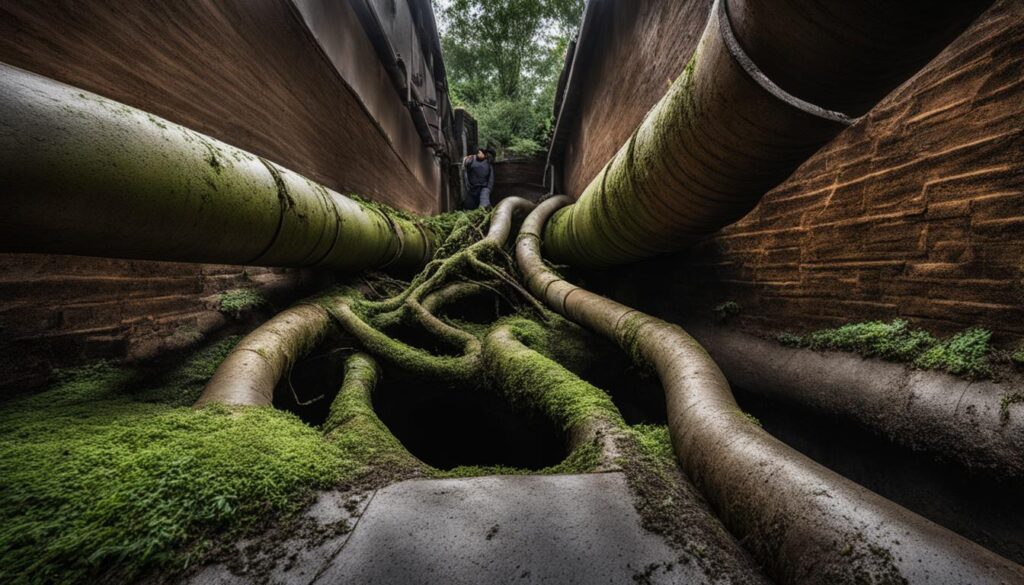If you’re facing the problem of tree roots in your sewer line, it’s crucial to take action before it leads to more damage and costly repairs. Tree roots in sewer lines can cause severe blockages and pipe damage, resulting in slow drains, unpleasant odors, and potential overflows. To prevent root intrusion and protect your pipes, it’s important to remove and kill the tree roots effectively.
In this article, we will discuss the various methods to remove tree roots in a sewer line, including the use of rock salt, foaming root killers, and copper sulfate. We will also explore the dangers that tree roots pose to sewer lines and the importance of acting promptly to prevent extensive damage. If you’re facing persistent root problems or if the DIY methods don’t work, we will recommend hiring a professional plumber for a long-term and permanent solution.
By the end of this article, you will have the knowledge and understanding to effectively combat tree roots in your sewer line, prevent costly damage, and ensure the continued functionality of your plumbing system. Let’s dive in and explore the best strategies to kill roots in a sewer line and protect your pipes from root intrusion.
Ways to Remove Tree Roots In a Sewer Line
When it comes to removing tree roots in a sewer line, there are several effective methods you can utilize. Each method offers its own unique approach to tackling the problem. By exploring these options, you can find the right solution for your specific situation.
1. Use Rock Salt: One method to consider is using rock salt, which works by pulling moisture from the tree roots and eventually killing them. To apply rock salt, simply pour it down the toilet, flush it multiple times, and allow it to sit for 12 hours. This process can help eliminate tree roots from the sewer line.
2. Use a Foaming Root Killer: Another effective option is to use a foaming root killer specifically designed to eliminate roots inside the pipe without causing harm to the tree. This chemical-based solution creates foam upon contact with water, allowing it to travel down the pipe and dissolve the roots in its path. It provides a targeted and efficient approach to root removal.
3. Use Copper Sulfate: Copper sulfate is known for its effectiveness in killing and removing tree roots. However, caution should be exercised as it can be toxic. This method involves using copper sulfate crystals or powder and following the proper safety precautions. The copper sulfate is applied directly to the sewer line, targeting and eliminating the roots present.
4. Inspect, Remove, and Repair the Damage: If you prefer a hands-on approach, you can inspect the damage, remove the roots manually, and repair the affected section of the pipe. This method requires digging up the area where the roots have infiltrated and physically eliminating them. It may be a more challenging and time-consuming task, but it can be an effective DIY solution.
5. Hire a Professional: In cases where the roots persist or the problem is extensive, it’s advisable to hire a professional plumber. Professionals have the experience, expertise, and specialized tools to locate the damage, remove the roots completely, and repair the sewer line efficiently. This ensures a long-term and permanent solution for your sewer line issues.
When it comes to removing tree roots from a sewer line, these methods provide reliable options to help you tackle the issue. Choose the method that suits your specific needs, whether it’s using rock salt, a foaming root killer, copper sulfate, or opting for professional services. Taking prompt action will ensure the health and functionality of your sewer line in the long run.
The Dangers of Tree Roots in Sewer Lines
Tree roots in sewer lines can cause severe damage and pose several risks. Roots grow in sewer lines because they provide an excellent source of moisture and nutrients. However, as they grow and expand, they can block and damage the pipes, leading to slow drains, unpleasant odors, and potentially damaging overflows.
The hydraulic capacity of the sewer system is greatly affected by the presence of tree roots. The roots can infiltrate the pipes, causing obstructions and reducing the flow of wastewater. This can lead to backups and the risk of sewage backing up into your home or property. The accumulation of debris and waste can exacerbate the problem, creating a breeding ground for bacteria and causing health hazards.
Furthermore, the roots can penetrate through cracks, deteriorated concrete, or rotted-out cast iron, causing blockages and even complete collapse of the sewer system. This can result in expensive repairs, property damage, and disruption to your daily life.
Sinkholes, gurgling toilets, and slow drains are all signs of potential tree root intrusion. These indicators should not be ignored, as they can signal underlying pipe damage that requires immediate attention.
It’s crucial to address tree roots in sewer lines promptly to prevent further damage and costly repairs. Regular inspection and maintenance of your sewer lines can help identify root intrusion before it becomes a major issue. If you suspect tree roots are causing problems in your sewer system, it’s recommended to consult with a professional plumber who can assess the situation and provide appropriate solutions.
Conclusion
When it comes to dealing with tree roots in your sewer line, taking immediate action is crucial in preventing costly damage. DIY methods like using rock salt, foaming root killers, or copper sulfate can effectively remove and kill tree roots. However, if the problem persists or becomes extensive, it is highly recommended to seek the assistance of a professional plumber.
A professional plumber has the expertise and specialized tools to locate the damage, remove the roots, and repair your sewer line, providing a long-term and permanent solution. By hiring a professional, you can ensure the protection of your pipes and prevent further damage.
Regular inspections and preventive maintenance are also important in identifying root problems early on, helping you to avoid major issues in the future. Taking proactive measures to kill tree roots in your sewer line is essential in protecting your pipes and preventing costly damage in the long run.
Will Killing Roots in Sewer Line Affect the Spider Webs in Grass?
Killing roots in the sewer line will not directly affect clearing spider webs safely in grass. However, it’s essential to ensure that any chemical treatments used in the sewer line do not harm the surrounding environment, including grass and its inhabitants like spiders. Prioritizing eco-friendly methods is crucial for maintaining a harmonious ecosystem.










